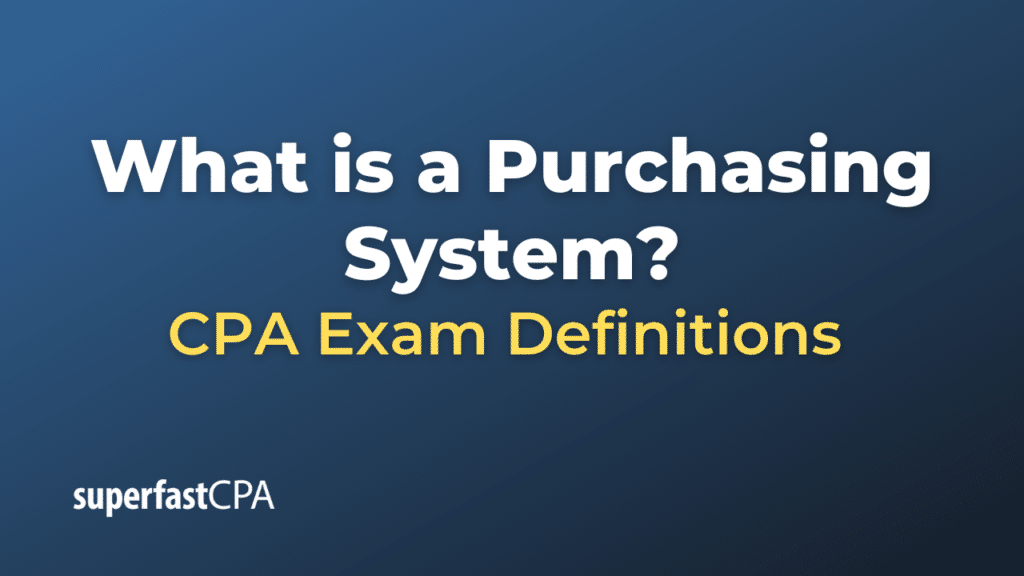Purchasing System
A purchasing system, also known as a procurement system, is a set of procedures and technology used by businesses to streamline the purchase of products and services. It covers everything from identifying the need for goods or services to placing orders, receiving goods, and processing invoices.
Purchasing systems can be manual or digital. However, many businesses now use digital purchasing systems (often referred to as e-procurement systems) because they can automate many aspects of the purchasing process, improving efficiency, reducing errors, and providing better visibility and control over spending.
Here are some key components of a purchasing system:
- Purchase Requisition: This is the initial request for goods or services. It might come from an individual, a department, or be generated automatically based on inventory levels.
- Supplier Selection : The system may include a list of approved suppliers, and mechanisms for selecting a supplier based on price, delivery times, quality, and other factors.
- Purchase Order (PO) Creation: Once a supplier is selected, the system generates a purchase order. The PO includes details such as the items being purchased, quantities, prices, delivery dates, and terms and conditions.
- Goods Receipt: When the goods are received, the system records the receipt and checks it against the original purchase order.
- Invoice Processing and Payment : The system checks the supplier’s invoice against the PO and goods receipt, and if everything matches, processes the invoice for payment.
- Record Keeping and Reporting : The system keeps records of all transactions and provides reports on spending, supplier performance, cost savings, and other key metrics.
- Integration with Other Systems: Purchasing systems often need to integrate with other business systems, such as inventory management, finance, and accounting systems.
A well-implemented purchasing system can help a business reduce costs, improve purchasing accuracy, ensure compliance with purchasing policies, and provide valuable data for decision-making.
Example of a Purchasing System
Let’s say we have a company named “Healthy Habits” that sells various health supplements online. They recently implemented a digital purchasing system to manage their procurement process.
Here’s how it works:
- Purchase Requisition: Based on their inventory management system, “Healthy Habits” identifies that they need to order 500 bottles of a particular vitamin supplement. The system automatically generates a purchase requisition for this product.
- Supplier Selection: The system has a list of approved suppliers. For this particular vitamin supplement, it suggests “Vital Vitamins,” a supplier with whom “Healthy Habits” has negotiated favorable pricing and delivery times.
- Purchase Order (PO) Creation: The purchasing system automatically creates a purchase order detailing the required items, quantity, price, and expected delivery date and sends it to “Vital Vitamins.”
- Goods Receipt: Upon receiving the shipment from “Vital Vitamins,” the staff at “Healthy Habits” check and confirm the goods received using the purchasing system. The system updates the inventory records and marks the received goods against the relevant PO.
- Invoice Processing and Payment: “Vital Vitamins” submits an invoice for the delivered goods. The purchasing system automatically matches the invoice with the relevant PO and the goods receipt record. If all details match, it schedules the invoice for payment.
- Record Keeping and Reporting: All these transactions are recorded in the system. Healthy Habits” can easily track the status of their orders, review the historical data for past purchases, assess the performance of their suppliers, and analyze their expenditure.
- Integration with Other Systems: The purchasing system at “Healthy Habits” is integrated with their accounting system. When an invoice is scheduled for payment, the information is automatically updated in their accounting system.
This example illustrates how a digital purchasing system can streamline and automate the purchasing process, improving efficiency, accuracy, and visibility of procurement in a company.













